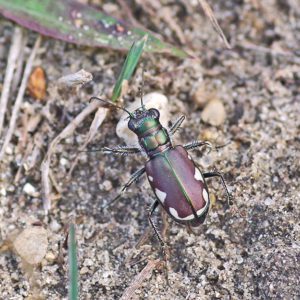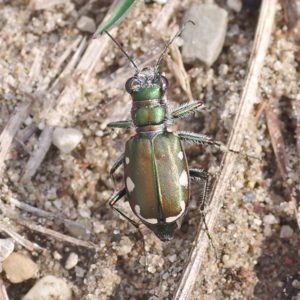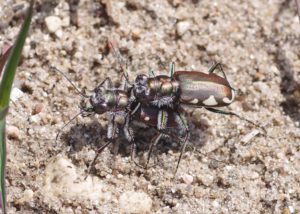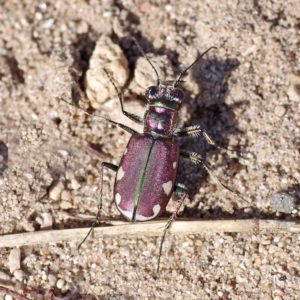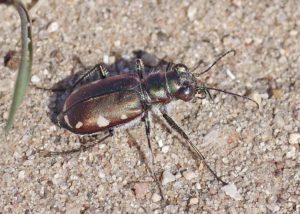Howdy, BugFans,
The BugLady has been enjoying the company of these lovely beetles on her walks over the prairie at Riveredge recently (no, despite the recent rash of Riveredge-based episodes, she does not own stock in Riveredge or even get free maple syrup – it’s just a very cool place to walk – and witness a little beetle hanky-panky).
The beetles live along a sandy trail, and as you walk toward them, they fly up in front of you for a few feet, often landing at the path’s edge where sparse grass begins. At just under a half-inch long, they’re not huge – the BugLady was showing them to someone one day, and they had thought the beetles were flies.
Tiger beetles used to be considered a separate family, but now they’re classified as the subfamily Cicindelinae in the ground beetle family Carabidae, a huge family with about 34,000 species worldwide, some 2,500 of them in North America. According to bugguide.net, there are 117 species of tiger beetles north of the Rio Grande (and almost as many subspecies – more about that in a sec). The BugLady has said it before – someone is sure having fun naming these beetles. Festive tiger beetles (Cicindela scutellaris) are in the tribe Cicindelini (Flashy tiger beetles) and in the genus Cicindela (Temperate tiger beetles).
They are famous for their boldness – after a short flight, tiger beetles often land and turn to face their stalker https://bugguide.net/node/view/894153/bgimage – and for their speed (there’s a reason why many tiger beetle pictures are of the beetle’s rear). They can hit 5 mph on all sixes; Jim McCormac, in his excellent Ohio Birds and Diversity blog says “they move in impossibly quick bursts, as if propelled by small explosives.” http://jimmccormac.blogspot.com/2009/04/tiger-beetles.html.
Festive tiger beetles are considered one of the most widely-distributed species of tiger beetles, present in the US east of the Rockies (except, oddly, in the Appalachians) and across southern Canada from Alberta to Quebec. They’re found in sandy, relatively unshaded habitats – paths, edges, and swales – away from water.
Tiger beetles have been discussed in these pages before (https://uwm.edu/field-station/tiger-beetles-revisited/), and a festive tiger beetle’s biography follows the general tiger beetle template. Briefly, it’s a two-year life cycle (but it’s not synchronized, so various stages are present each year). According to the University of Michigan Animal Diversity Web account of Festive tiger beetles, “Females lay about 50 eggs in dry sand or sandy soils. Each egg is deposited into its own hole, about 5 to 10 mm deep. Larvae develop to the 3rd instar stage in their first summer and hibernate over the winter. In the following spring they become active and begin feeding, then pupate in June and July. They emerge as adults in August, often after a soaking rain. Adults overwinter in a burrow and are sexually mature when they emerge the next spring.” The BugLady was surprised to see this beetle in May – she’s accustomed to chasing them in September – but she learned that they’re typically seen in late spring and then again at the end of summer.
The well-camouflaged larva lurks at the mouth of a vertical tunnel of its own creation https://bugguide.net/node/view/1480242/bgimage (the female’s choice of a soil type for her eggs is critical), waiting for small, unwary pedestrians to pass by. Having nabbed some prey, they retire with it to the bottom of their lair. Adults are carnivores, too, chasing ants and other invertebrates. Adults are eaten by spiders, robber flies, and a few birds and mammals, and larvae by wasps, ants, and some beetles.
Festive tiger beetle are diurnal, and ground temperatures in their habitat can swing between extremes, but the beetles have strategies for that. Overheated beetles may shelter under vegetation or may tunnel shallowly into the sand, and they may also stay underground at night, when the sand’s surface cools. They aestivate (from the Latin for “summer”), disappearing during the hottest months. Like some other insects, they bask in the sun to increase their internal temperature when they’re chilly, and they stand “on tiptoe” to get away from the heat https://bugguide.net/node/view/1062656/bgimage when they’re hot.
According to Eric Eaton at bugeric.blogspot.com, “The metallic nature of tiger beetles is structural, rather than the result of pigmentation. Layers in the exoskeleton reflect various wavelengths of light.” Even though brightly-colored, the patterns on the adults elytra break up their body shape visually and can make them hard to spot.
Not only are Festive tiger beetles considered one of the most widely-distributed species of tiger beetles, they are also among the most variable species of tiger beetles, and that’s because entomologists have described a bunch of subspecies.
What’s a subspecies? Within a species’ range, especially if it covers a wide geographic area, populations may take on a unique appearance, lined up in a continuum across their range. They’re the same species genetically– they could still interbreed more-or-less successfully (for now) if they met up with each other, though they might not recognize each other. They may be on the way to becoming distinct species. In appearance, (phenotype) they’re different, due to environmental factors – different enough that scientists give them an extra name that indicates their separateness. Our Upper Midwestern Festive beetle is Cicindela scuttelaris lecontei, aka C. s. lecontei.
The folks at the Animal Diversity Web list these subspecies and ranges (there may be a mix of subspecies in an area), and the BugLady added pictures from bugguide.net. Remember – at present, this is a single species. .
- s. scutellaris(Festive tiger beetle). West of the Missouri River. https://bugguide.net/node/view/1722649/bgimage, and https://bugguide.net/node/view/1479472/bgimage;
- s. flavoviridis,(Chartreuse tiger beetle). Central northern Texas. https://bugguide.net/node/view/1504640/bgpage;
- s. lecontei(Leconte’s tiger beetle)– that’s us! Throughout the northeast and Midwestern states. https://bugguide.net/node/view/1635202/bgimage, and https://bugguide.net/node/view/747313/bgimage;
- s. rugata(Rugate tiger beetle). From eastern Texas to western Arkansas. https://bugguide.net/node/view/623060/bgimage;
- s. rugifrons(Festive tiger beetle). Along the Atlantic seaboard from Massachusetts to the Carolinas. https://bugguide.net/node/view/1059359/bgimage, and https://bugguide.net/node/view/659944/bgimage;
- s. unicolor(Unicolored tiger beetle). Southeastern Coastal Plain and scrubinto Missouri and Tennessee. https://bugguide.net/node/view/569015/bgimage and https://bugguide.net/node/view/894148/bgimage;
And C. s. yampae (Yampa tiger beetle). Found only in northwestern Colorado. https://bugguide.net/node/view/1631754/bgimage.
If you want more than the Cliff’s Notes version, see https://animaldiversity.org/accounts/Cicindela_scutellaris/
Can’t get enough of these great beetles? Here are a few picture collections: https://whyevolutionistrue.wordpress.com/2015/08/13/readers-wildlife-photos-207/, and
http://bugeric.blogspot.com/2015/04/springtime-tiger-beetles.html, and http://www.wvdnr.org/publications/PDFFiles/tigerbeetlebrochure.pdf, and our home town tiger beetles https://wisconsinbutterflies.org/tigerbeetle/family/35-tiger-beetles.
Kate Redmond, The BugLady
Bug of the Week archives:
http://uwm.edu/field-station/category/bug-of-the-week/

